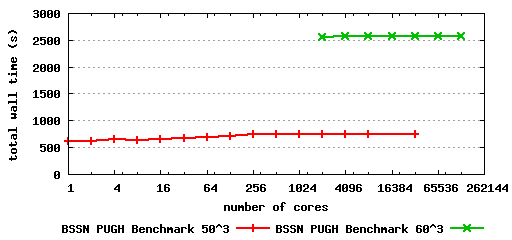Cactus runs on 131,072 cores on Blue Gene/P at ANL
During the Leap to Petascale Workshop held at the Argonne Leadership Computing Facility (ALCF) in July 2008, the Cactus team successfully ported the Cactus framework to the Blue Gene/P system at the Argonne National Laboratory (ANL) and conducted benchmarking runs on up to 131,072 cores (out of 163,840 cores available).
There are two IBM Blue Gene/P systems, Intrepid and Surveyor, installed at ANL.
- Intrepid has 40,960 quad-core compute nodes (163,840 cores) with a peak performance of 557.1 TFlop/s.
- Surveyor has 1,024 quad-core compute nodes (4096 cores) with a peak performance of 13.6 TFlop/s.
Although Intrepid is ranked as the world’s third fastest supercomputer in the 31st TOP500 list in June 2008, it is the world’s fastest open science supercomputer. The Cactus team carried out standard weak scaling benchmarking runs with uniform grid driver PUGH on Intrepid on up to 131,072 cores with a local grid size of 503 and 603 respectively. The total number of grid points of the biggest run is 30483 or about 28.3 billion, which is the largest simulation that the Cactus team has ever performed on any supercomputer so far. The benchmark used is the kernel of a numerical relativity code which evolves the Einstein equations to model black holes and gravitational waves. The almost perfect weak scaling behavior of Cactus on the Blue Gene/P system as shown in the figure below indicates that Cactus is ready to leap to the Petascale.
We would like to thank Kalyan Kumaran and other ALCF staff members for
their help during the Leap to Petascale Workshop. Our thanks also go to
the on-site IBM support team for their help. As part of the
XiRel
and
ALPACA
projects, this work is supported by the National Science Foundation
under Grant No. 0701566 and 0721915.

